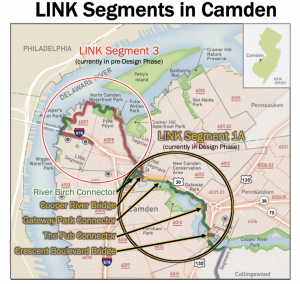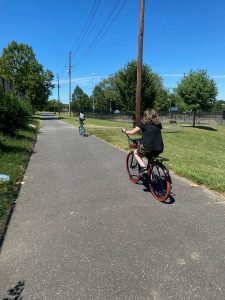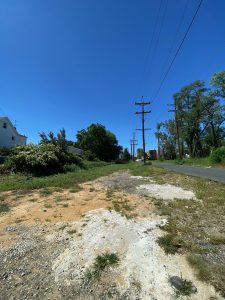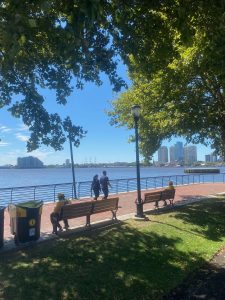New Jersey Future Blog
Accessing New Federal Funding for Active Transportation Projects: Camden County Got a Bunch, How Can You?
September 18th, 2023 by Zeke Weston
The Infrastructure Investment and Jobs Act (IIJA) was signed into law by President Joe Biden on November 15, 2021, investing $1.2 trillion in America’s infrastructure. From the IIJA, New Jersey municipal, county, and state governments have the opportunity to tap into once-in-a-generation funding programs, many of which support safe and accessible transportation alternatives for walkers, bikers and rollers. Camden County took advantage of the IIJA opportunity to secure $19 million in federal funding to design and build a new 3.8 mile section of the LINK trail. These new trail segments will connect existing trail segments from the Benjamin Franklin Bridge in Camden to Cooper River Park in Pennsauken.

Camden City LINK Trail Map courtesy of the Bicycle Coalition of Greater Philadelphia
The Camden County LINK Trail is a 34-mile multi-use, off-road trail that, when completed, will connect 17 communities in Camden County and serve as the southeast section of the Circuit Trails Network in New Jersey. The LINK is part of a growing network of trail segments that are expected to eventually connect Philadelphia, PA to Cape May, NJ. Funding for the 3.8 mile Camden LINK was awarded from the Rebuilding American Infrastructure with Sustainability and Equity (RAISE), a discretionary grant program from the IIJA. RAISE grants can be used to invest in road, rail, transit or port projects, but Camden took advantage of it to expand their trail network, demonstrating that there are opportunities for active transportation projects to access funding.

Two kids riding their bikes on an existing LINK Trail segment through East Camden
“Hundreds of people will be able to walk less than ten minutes to new public amenities,” explained Justin Dennis, Camden Program Director with the Trust for Public Land (TPL), on the importance of the Camden LINK. Many Camden residents will be able to walk or bike directly onto the LINK from their neighborhood. From there, the travel and recreation opportunities are vast and include access into downtown and numerous parks throughout the city. The safety of non-motorized users will be prioritized, so that residents can comfortably and safely rely on the trail network. Therefore, the Camden LINK Trail is not simply a recreational amenity, but more importantly an accessible and equitable regional connector. Dennis believes that the “LINK will improve the mental health and social cohesion of the community.” Project boosters hope the LINK Trail will be more than a leisure-oriented mixed-use path, and instead serve as an arterial transportation network for folks to get to and from their destination of choice without the need for or reliance on a car.
Felix Moulier, Project Manager for the Saint Joseph’s Carpenter Society, an East Camden non-profit that focuses on affordable housing and neighborhood development, grew up in Camden and recently moved back to live and work. The more Moulier learns about the LINK trail, the more he understands its value. “The trail’s influence on beautification is an instant win because it has an immediate impact,” he claimed. The creation of trail networks includes trees, flowers, benches and other components that alter the landscape of the community, in turn improving perception of the neighborhood among local residents and visitors. Households and individuals are anticipated to find green neighborhoods more welcoming to rent or buy property, or simply to enjoy local shops, museums, eateries, and other public amenities. Importantly, city residents will no longer have to travel out of their neighborhood to access public green spaces, improving the quality of life for the community. Thus, it serves as an example of how well-developed active transportation networks can positively influence communities in various ways, including providing reliable access to green and open spaces and connecting residents to their local waterway.


The picture on the left is of an undeveloped trail segment in East Camden, while the picture on the right is of a developed trail segment on the same road.
Francisco Moran, ex-Camden City Council President and Mayor, expressed that multi-use trail networks are “particularly important in a city like Camden, where one-third of the residents don’t own cars.” The new LINK Trail segments will better enable community members who don’t own cars or don’t want to drive, to travel around the city. Residents will not have to rely on cars to get around, rather they can walk or bike to their destination of choice. The lack of bicycle and pedestrian infrastructure in the city has been a major safety concern for folks attempting to get around without a car. The LINK will ensure pedestrians and cyclists have a safe and reliable route to travel through the city.


LINK Trail segment along the Delaware River in Camden
IIJA Funding Opportunities
The expanded grant opportunities provided by the IIJA, like the RAISE program that will fund the Camden LINK, will not last forever. IIJA funding is only available through fiscal year 2026 and the application process is extensive. Competitive projects often require feasibility studies, a planning and design process, and various other components that cannot be rushed. Therefore, the time to begin identifying and thinking about potential projects is now. In addition to RAISE, there are multiple IIJA programs that can be accessed for active transportation and complete streets initiatives. The Safe Streets and Roads for All competitive grant program funds Vision Zero initiatives that seek to make access and mobility safer for non-motorized users. The national $5 billion program can be used for active transportation projects that are likely to significantly reduce transportation related deaths and injuries. The Transportation Alternatives Set-Aside (TASA) is a program that has more than doubled in size under the IIJA that can be used for active and multimodal transportation projects, including bicycle and pedestrian facilities and complete streets. The process for applying to the IIJA programs begins long before the respective program deadline. Competitive applications include planning and feasibility studies to demonstrate project viability. This may require applicants to hire a consultant and is just one of numerous application requirements. Therefore, it is important to begin the planning process as soon as possible. Application costs may be covered by government agencies (see below), but even if not, they can unlock large grants. To gain a better understanding of the IIJA program and its potential uses, visit the State of NJ IIJA homepage. For help getting started on applying to the IIJA programs, visit your region’s Metropolitan Planning Organization’s (MPO) IIJA webpage: the Delaware Valley Regional Planning Commission (DVRPC), the North Jersey Transportation Planning Authority (NJTPA), or the South Jersey Transportation Planning Organization (SJTPO). Additionally, folks interested in learning more about how to access the active transportation opportunities in New Jersey can email NJDOT’s Office of Bicycle and Pedestrian Programs (BIKEPED dot
dot nj
nj gov) or the New Jersey Bicycle and Pedestrian Advisory Council (BPAC) (bikeped
gov) or the New Jersey Bicycle and Pedestrian Advisory Council (BPAC) (bikeped ejb
ejb rutgers
rutgers edu) for more information.
edu) for more information.
For help determining who to reach out to and how, feel free to email New Jersey Future’s Land Use Policy Coordinator, Zeke Weston (zweston njfuture
njfuture org) .
org) .
Related Posts
Tags: accessibility, active transportation, camden, federal funding, funding, grant opportunities, infrastructure, Infrastructure Investment and Jobs Act, LINK trail, Open Space, safe transportation, trails, Transportation
















